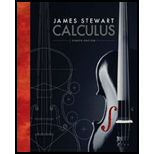
(a) Show that the series
(b) Find an upper bound for the error in the approximation
(c) What is the smallest value of n such that this upper bound is less than 0.05?
(d) Find
Want to see the full answer?
Check out a sample textbook solution
Chapter 11 Solutions
Calculus (MindTap Course List)
- Find the 3rd degree Maclaurin Polynomial for f(x) = 2". d Recall that dx In(b) - b². T3(x) Then the Maclaurin series for f(x) = 2" is: T(x) = n=0 Your answer may disappear. The bug has been reported and is being worked on. And this series converges on the interval: enter answer in interval notation. Use oo for oo.arrow_forwardThe series is convergent. (A). According to the Remainder Estimate for the Integral Test, the error in the approximations, is 16-8n) ≤ f(x) dx = n 1 (6n +4)³ (B). Find the smallest value of n such that the error in the approximation is less than 0.00004 n= 125 Note: You can earn partial credit on this problem.arrow_forwardsum Sn. (b) Use (a) to determine whether the series is convergent or divergent. 8 (5) Decide whether each of the following statements is true or false. If a statement is true, explain why. If a statement is false, provide specific examples of ak and Σb for k=1 which the statement is false. Σ (a) If 5 am is a series such that ak a k=1 1 k² < ak for all k, then (d) If ak k=1 (b) If ak is a series such that 0 < aarrow_forwardFind a power series for the function, centered at c. f(x)= 2/(5-x). c=-4 determine the interval of convergencearrow_forwardHow would I find if the sequences an=nπ cos(nπ) and an= (n2)(1/n) are convergent/divergent?arrow_forwardThe function f(x) = ekx² can be expressed in power series form. If A is the approximate value of f(x) at x = 0.767 when the series is truncated to five terms and B is the approximate value of f(x) at x = 0.767 when the series is truncated to four terms, what is the absolute error between A and B given that k = 3? Round off the final answer to five decimal places but do not round off on preliminary calculations.arrow_forwardLet f be a positive, continuous, and decreasing function for x ≥ 1, such that a = f(n). If the series n = 1 converges to S, then the remainder R₁ = S-S₁ is bounded by an 5. √° F(x) Use the result above to approximate the sum of the convergent series using the indicated number of terms. (Round your answers to four decimal places.) OSRNS 00 n = 1 1 n² + 1 f(x) dx. twelve terms Include an estimate of the maximum error for your approximation.arrow_forwardShow full steps pleasearrow_forwardfind the series' interval of convergence and, within its interval, the sum of the series as a function of x.arrow_forwardUse the power series 00 1 E(-1)"x". > |x| < 1 1+ x n = 0 to find a power series for the function, centered at 0. -2 1. 1 h(x) = + x? - 1 1 +X 1- x h(x) = E n = 0 Determine the interval of convergence. (Enter your answer using interval notation.)arrow_forwardWe define a new function h via the equation n! h(x) =E (2n)! Notice that h is defined as a power series. Its interval of convergence is R. (You do not need to prove this.) 1. Find the equation of the line tangent to the graph of h at the point with x-coordinate 0.arrow_forward[41] Consider the power series in number 3 and use the previous item to find its interval of convergence.arrow_forwardarrow_back_iosarrow_forward_ios
 Calculus: Early TranscendentalsCalculusISBN:9781285741550Author:James StewartPublisher:Cengage Learning
Calculus: Early TranscendentalsCalculusISBN:9781285741550Author:James StewartPublisher:Cengage Learning Thomas' Calculus (14th Edition)CalculusISBN:9780134438986Author:Joel R. Hass, Christopher E. Heil, Maurice D. WeirPublisher:PEARSON
Thomas' Calculus (14th Edition)CalculusISBN:9780134438986Author:Joel R. Hass, Christopher E. Heil, Maurice D. WeirPublisher:PEARSON Calculus: Early Transcendentals (3rd Edition)CalculusISBN:9780134763644Author:William L. Briggs, Lyle Cochran, Bernard Gillett, Eric SchulzPublisher:PEARSON
Calculus: Early Transcendentals (3rd Edition)CalculusISBN:9780134763644Author:William L. Briggs, Lyle Cochran, Bernard Gillett, Eric SchulzPublisher:PEARSON Calculus: Early TranscendentalsCalculusISBN:9781319050740Author:Jon Rogawski, Colin Adams, Robert FranzosaPublisher:W. H. Freeman
Calculus: Early TranscendentalsCalculusISBN:9781319050740Author:Jon Rogawski, Colin Adams, Robert FranzosaPublisher:W. H. Freeman
 Calculus: Early Transcendental FunctionsCalculusISBN:9781337552516Author:Ron Larson, Bruce H. EdwardsPublisher:Cengage Learning
Calculus: Early Transcendental FunctionsCalculusISBN:9781337552516Author:Ron Larson, Bruce H. EdwardsPublisher:Cengage Learning





